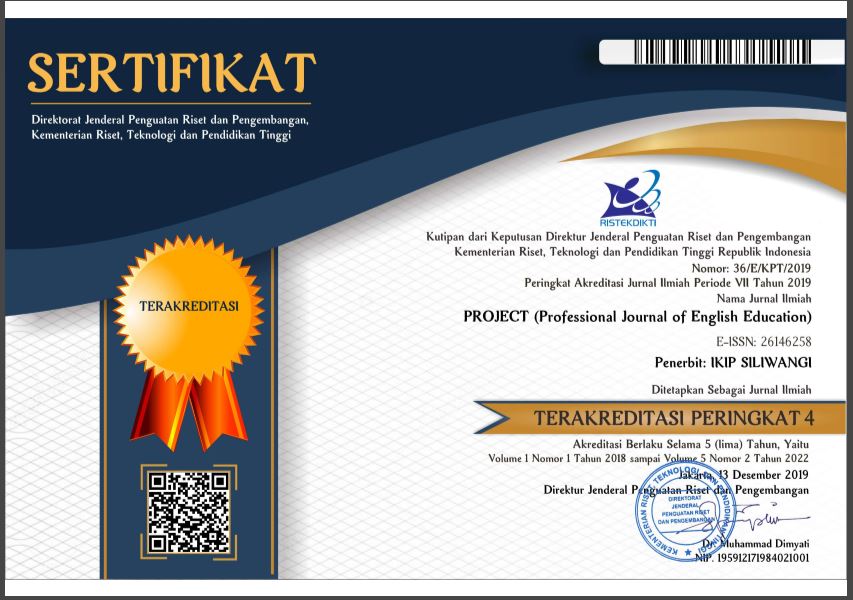DESIGNING WEB-BASED LEARNING MEDIA TO SUPPORT NARRATIVE TEXT READING COMPREHENSION
Abstract
This study is aimed at designing a web-based learning media and finding its appropriateness in supporting the ninth-grade students’ narrative text reading comprehension in SMPN 16 Singkawang. The ADD design from ADDIE was employed in this study, with observation, interview, and expert validation as the data collection technique. The results of the observation and interview revealed the need for learning media to address the difficulties in comprehending narrative texts among the students. Expert validations revealed that the designed product was very valid in terms of media and material design, with percentages of 85.3% and 96.3%, respectively. The final product includes multimedia and four reading texts translated and adapted from Singkawang local folktales. In conclusion, the web-based learning media was considered as an appropriate medium to be utilized by the students.
References
Adanan, H., Adanan, M., & Herawan, T. (2020). M-webquest development: Reading comprehension of senior high school students in Indonesia. International Journal of Emerging Technologies in Learning, 15(3), 74–92. https://doi.org/10.3991/ijet.v15i03.10628
Akbar, S. (2013). Instrumen Perangkat Pembelajaran. Rosdakarya.
Branch, R. M. (2009). Instructional design: The ADDIE approach. Springer Science & Business Media. https://doi.org/10.1007/978-0-387-09506-6
Cook, D. A., & Dupras, D. M. (2004). A practical guide to developing effective web-based learning. Journal of General Internal Medicine, 19(6), 698–707. https://doi.org/10.1111/j.1525-1497.2004.30029.x
Figna, H. P., Rukun, K., & Irfan, D. (2020). The practicality and effectiveness of web-based learning media. Progress in Social Science, Humanities and Education Research Symposium, 5, 52–56. https://doi.org/https://doi.org/10.32698/GCS-PSSHERS344
Ghani, M. T. A., & Daud, W. A. A. W. (2018). Adaptation of ADDIE instructional model in developing educational website for language learning. Global Journal Al-Thaqafah, 8(2), 7–16. https://doi.org/10.7187/GJAT122018-1
Heaster-Ekholm, K. L. (2020). Popular instructional design models: Their theoretical roots and cultural considerations. International Journal of Education and Development Using Information and Communication Technology (IJEDICT), 16(3), 50–65.
McGrath, I. (2016). Materials evaluation and design for language teaching. Materials Evaluation and Design for Language Teaching. https://doi.org/10.1515/9780748694822
Purwasari, R. M., & Purnamaningsih, I. R. (2022). Implementation of technology-based learning media: Student attitudes and experiences. Professional Journal of English Education (PROJECT), 5(4), 842–849.
Radovan, M., & Perdih, M. (2016). Developing guidelines for evaluating the adaptation of accessible web-based learning materials. International Review of Research in Open and Distance Learning, 17(4), 166–181. https://doi.org/10.19173/irrodl.v17i4.2463
Roslan, A., Razak, T. R., Ismail, M. H., & Halim, I. H. A. (2022). An e-quiz system: A pathway to improve English learning for preschoolers in rural areas. Journal of Computing Research and Innovation, 7(2), 272–282. https://doi.org/10.24191/jcrinn.v7i2.319
Smaldino, S. E., Lowther, D. L., & Russell, J. D. (2014). Instructional technology and media for learning (10th ed.).
Supratman, Arianto, T., & Maiyana, E. (2020). Development of local web-based learning (LWBL) as low-cost digital learning efforts. Journal of Physics: Conference Series, 1471(1). https://doi.org/10.1088/1742-6596/1471/1/012003
Supriati, R., Bunau, E., & Salam, U. (2023). Developing West Kalimantan folklore videos for narrative text material. Journal of English Education Program, 4(2), 67–77. https://doi.org/10.26418/jeep.v4i2.62253
Tomlinson, B., & Masuhara, H. (2017). The complete guide to the theory and practice of materials developement for languagle learning. John Wiley & Sons, Inc.
Yuliana, Y. G. S. (2022). Internet-based learning media in the digital era of EFL learning in English education master program (S2 be)”. Journal of English Educational Study (JEES), 5(1), 57–66. https://doi.org/10.31932/jees.v5i1.1491
Downloads
Published
Issue
Section
License

This work is licensed under a Creative Commons Attribution-ShareAlike 4.0 International License.




